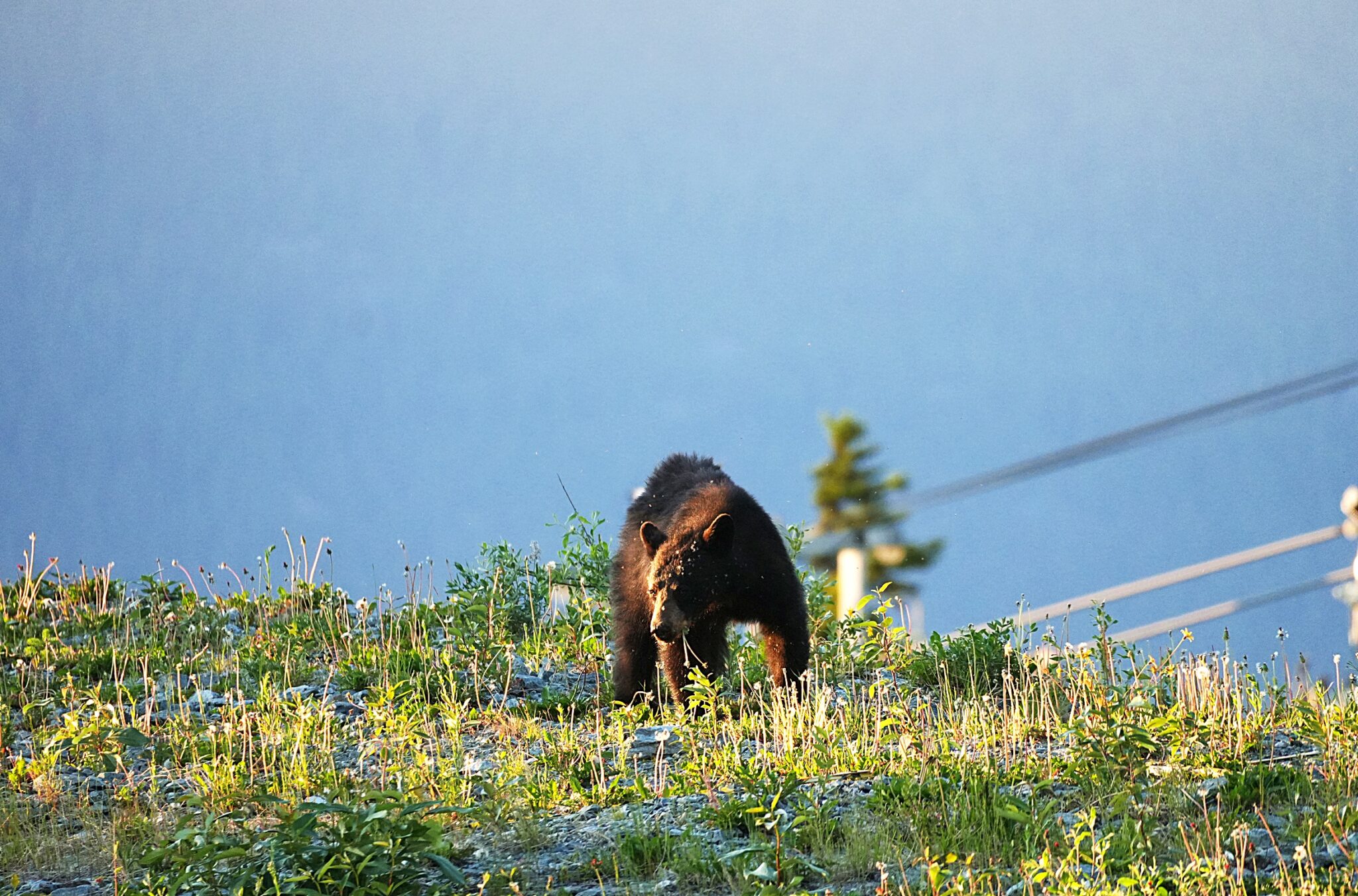A large black lump ambles through the field, visible through tall grasses and wildflowers. Our group is gathered at a safe distance, speaking in hushed voices and passing a pair of binoculars among us. We are a short walk away from our vehicle, having been alerted by another tour group that there is something to see in this lush, alpine field.
View this post on Instagram
The black lump is the backside of one of 50+ wild black bears that reside all over Whistler Blackcomb and the first one we’ve spotted on our bear viewing tour. It turns its body and raises its head in our direction, still chewing. Aware of our presence but unconcerned due to the distance between us, it continues to munch peacefully. I take the opportunity to capture some photos of the bear with its head raised before it lowers again and resumes its meal, oblivious to the thrill it’s generated amongst us.

Slowing Down to See More
Whistler Blackcomb is world-renowned for faster-paced thrills including downhill skiing and snowboarding, mountain biking and even ziplining. As a Whistler resident, I have explored the resort countless times through these gravity-fueled activities and felt I knew the mountains fairly well.
However, when caught up in the thrill of speed, it’s easy to miss the subtle details throughout the landscape. On a bear viewing tour, I discovered how much more there is to appreciate when you take the time to pause and look around.
It’s common to see black bears dotted amongst the open ski runs while riding up the mountain in the gondola, as they love to graze on the grass in the cleared areas. However, bear tours give you the opportunity to slow down, zoom in and take a closer look.
Why Go on a Bear Tour
Connecting with our guide, Theresa, throughout the tour was fascinating as she shared her knowledge and experiences with us while we chatted and asked questions. Our group included a mixture of locals and tourists, and we all learnt a lot about bears and their habitats on the tour while getting to observe them in the wild.
We checked out a bear’s den located just steps away from a popular ski run. It was wonderful to uncover this hidden detail and to imagine the possibility of skiing right past a slumbering bear during the winter, completely unaware of its presence.

What I found particularly special about the tour was that it took us all over the mid-mountain via the zig-zagging dirt road system, a vast area that you wouldn’t otherwise get to discover outside of the ski season. It provides an accessible way for people to explore the mountains while relaxing in a comfortable vehicle.
Black Bear Insights

Wildlife of Whistler Blackcomb
During our tour, I was amazed to discover the rich biodiversity of the mountains during summer. Despite the absence of other people, the landscape was alive with movement and colour. The variety of flowers, trees, and other flora was accompanied by insects, birds and mammals — from tiny squirrels to the stars of the show, the black bears.
While we drove around looking for bears, we discovered other residents of the resort. One particular creature took a while for us all to spot, as it was sat on the road and blended in with its greyish-brown surroundings. We thought it may be a grouse, until it flew up to a nearby tree and we could observe it a bit better and saw that it was a gorgeous bird of prey.

Throughout the tour we saw five different black bears, and we also eventually saw an actual grouse. We saw several chipmunks and squirrels, which is always very exciting for people who come from countries that don’t have them, much to the surprise of Canadians who are used to seeing them all the time.
What to Expect on a Bear Viewing Tour
Whistler Blackcomb bear viewing tours last for three hours, so it’s a good idea to eat something beforehand. Do not bring food with you on the tour, as it could impact the bear viewing experience. Bears have an incredibly keen sense of smell, estimated to be seven times more sensitive than that of dogs. Similarly, avoid wearing bug spray or perfumes, as unfamiliar scents might cause bears to shy away.

The temperatures can vary with the changing elevations, so dress for the weather, but also bring extra layers. You’ll go for short walks on uneven ground, so wear sturdy footwear. Bring binoculars if you have them, however they are not a necessity as there will be one pair to share amongst the group.
It’s important to note that as with any wildlife viewing experience, sightings are never guaranteed. However, joining a bear viewing tour is the best way to increase your chances of seeing black bears while in Whistler. It’s also the safest way to observe them, allowing you to explore their habitats, discover the mountains, and learn about Whistler’s most iconic animal residents.
Spring offers great value with savings of up to 25% on lodging. Stretch your stay into midweek for even more savings and a quieter village. For every third night you book between March 1 - April 30, 2025, receive a free $75 CAD Whistler Après Voucher.
For summer, book ahead and save up to 30% on lodging. Plus, you'll receive a free $150 CAD Activity Voucher on stays of 3 or more nights.
Insider Tip: BC or Washington resident? Sign up for Whistler Rewards to access additional savings and exclusive perks.


